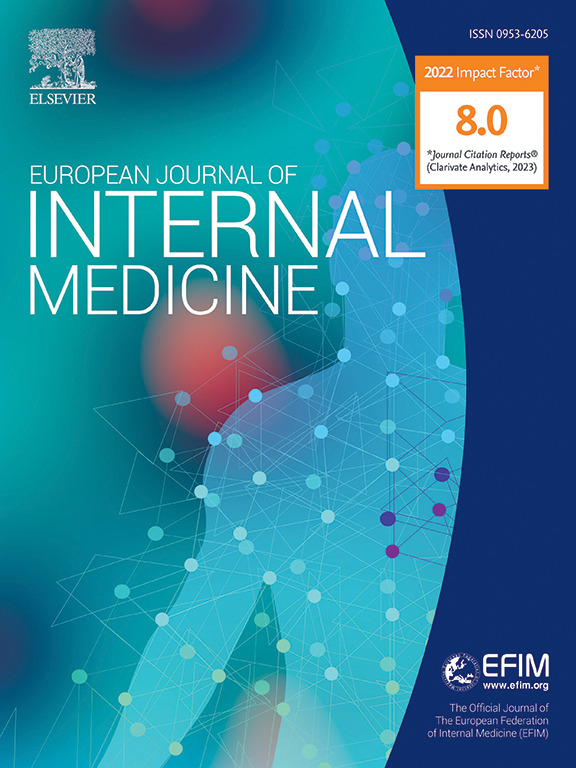2 型糖尿病患者风险因素控制程度与全因死亡率之间的关系:前瞻性队列研究。
IF 5.9
2区 医学
Q1 MEDICINE, GENERAL & INTERNAL
引用次数: 0
摘要
目的:评估通过对传统心血管风险因素进行最佳控制,是否以及在多大程度上降低了2型糖尿病患者全因死亡的超额风险:这项观察性、前瞻性、队列研究于 2006-2008 年间在意大利 19 个中心招募了 15773 名白种人患者。研究人员根据目标外风险因素的数量对参与者进行了分层:血红蛋白 A1c、血压、微/宏观白蛋白尿、当前吸烟、低密度脂蛋白胆固醇和甘油三酯。截至 2015 年 10 月 31 日,共检索到 15656 名患者(99.3%)的全因死亡率:与同时期的意大利普通人群相比,RIACE队列中所有患者的年龄调整后死亡率和危险比明显升高(升高幅度在20%~20%之间),患有心血管疾病(CVD)的患者的年龄调整后死亡率和危险比也明显升高(升高幅度在100%~100%之间),而未患有心血管疾病(CVD)的患者的年龄调整后死亡率和危险比则没有明显升高。在所有患者和未患过心血管疾病的患者中,根据目标外风险因素的数量与死亡率的关系呈 "J "形,在排除 "过度治疗 "患者(即使用抗高血糖药物导致低血糖和/或使用抗高血压药物导致收缩压≤120 mmHg的患者,血红蛋白A1c≤6.0%)或调整 "过度治疗 "后,这种影响减弱。相反,对于曾患心血管疾病的患者,所有类别的死亡率仍高于普通人群,并从+70%逐渐增加到+314%,没有J效应:结论:对于 2 型糖尿病患者,只要不 "过度治疗",对传统心血管风险因素的最佳治疗可完全消除与普通人群相比过高的死亡率风险。然而,只有在没有心血管疾病史的参与者中才能观察到这种效果:试验注册:ClinicalTrials.gov,NCT00715481,2008 年 7 月 15 日回顾性注册。本文章由计算机程序翻译,如有差异,请以英文原文为准。
Relationship between degree of risk factor control and all-cause mortality in individuals with type 2 diabetes: A prospective cohort study
Aims
To assess whether and to what extent excess risk of all-cause death is reduced in individuals with type 2 diabetes by achieving optimal control of traditional cardiovascular risk factors.
Methods
This observational, prospective, cohort study enrolled 15,773 Caucasian patients in 19 Italian centres in 2006–2008. Participants were stratified according to the number of the following risk factors outside target: haemoglobin A1c, blood pressure, micro/macroalbuminuria, current smoking, LDL cholesterol, and triglycerides. All-cause mortality was retrieved for 15,656 patients (99.3 %) on 31 October 2015.
Results
Age-adjusted mortality rates and hazard ratios were significantly higher in the whole RIACE cohort (by ∼20 %) and in patients with (by ∼100 %) but not in those without prior cardiovascular disease (CVD), as compared with the coeval Italian general population. In all patients and in those without prior CVD, the relationship with mortality according to the number of risk factors outside target was J-shaped, an effect that was attenuated after either excluding “overtreated “ patients, i.e., those with haemoglobin A1c ≤6.0 % on anti-hyperglycaemic agents causing hypoglycaemia and/or systolic blood pressure ≤120 mmHg on anti-hypertensive agents, or adjusting for “overtreatment”. Conversely, in patients with prior CVD, mortality remained higher than in the general population in all categories and increased progressively from +70 % to +314 %, without J-effect.
Conclusions
In patients with type 2 diabetes, optimal treatment of traditional cardiovascular risk factors completely eliminated the excess mortality risk versus the general population, provided that they were not “overtreated”. However, this effect was observed only in participants without history of CVD.
Trial registration
ClinicalTrials.gov, NCT00715481, retrospectively registered 15 July 2008.
求助全文
通过发布文献求助,成功后即可免费获取论文全文。
去求助
来源期刊
CiteScore
9.60
自引率
6.20%
发文量
364
审稿时长
20 days
期刊介绍:
The European Journal of Internal Medicine serves as the official journal of the European Federation of Internal Medicine and is the primary scientific reference for European academic and non-academic internists. It is dedicated to advancing science and practice in internal medicine across Europe. The journal publishes original articles, editorials, reviews, internal medicine flashcards, and other relevant information in the field. Both translational medicine and clinical studies are emphasized. EJIM aspires to be a leading platform for excellent clinical studies, with a focus on enhancing the quality of healthcare in European hospitals.

 求助内容:
求助内容: 应助结果提醒方式:
应助结果提醒方式:


